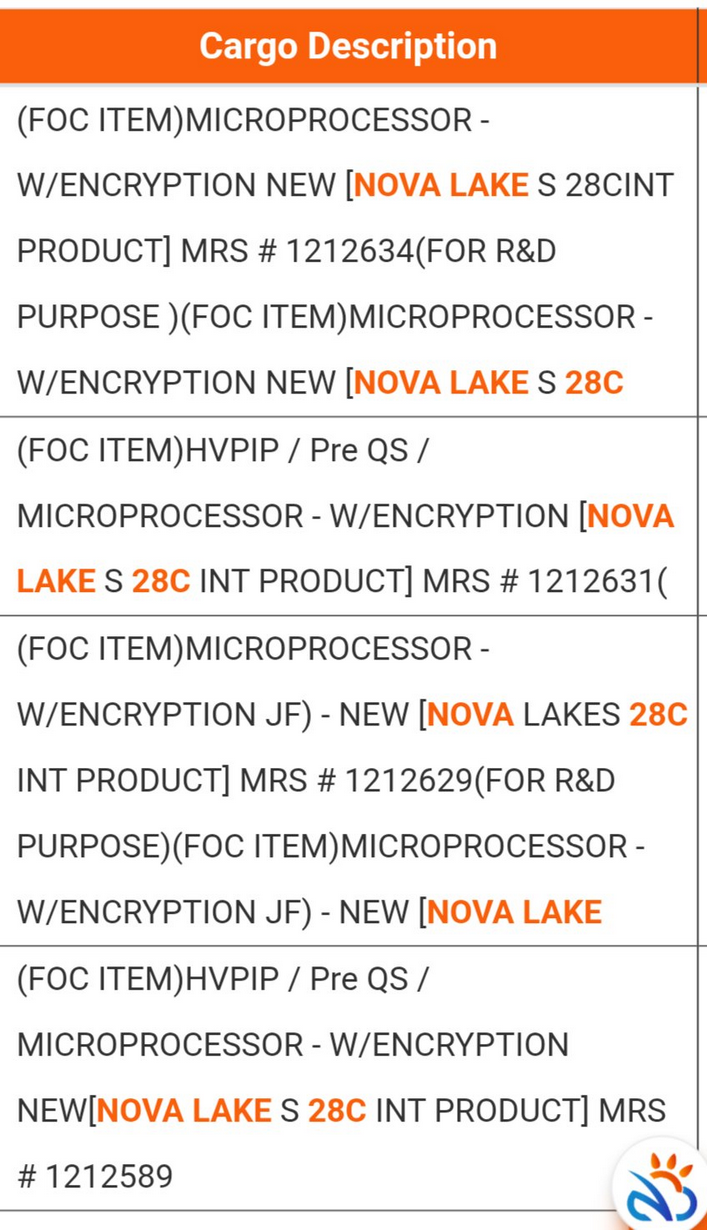Leaked Intel Nova Lake-S shipping manifest hints at 28-core CPU — possible counter to AMD's Ryzen 8000 line-up
What appears to be a leaked shipping manifest may have given us the first glimpse at Intel’s post-Arrow Lake ambitions.

Yesterday, @x86deadandback posted over on X, what appears to be a Nova Lake-S entry tagged as a pre-qualification sample with a surprising 28-core configuration. If accurate, that would mark a sizable jump over the current top Arrow Lake-S and even Raptor Lake-S parts, both capped at 24 cores. For now, take the news with the relevant dosage of salt.

The manifest simply lists a 28-core Nova Lake-S part. While the document doesn’t break down the core types, earlier Nova Lake mobile leaks pointed to a potential eight P-core, 16 E-core, and four low-power LP-E core configuration, which could carry over to desktop. Though, this is of course unconfirmed.
While Arrow Lake’s Core Ultra 9 285K sticks to the familiar eight P-core, 16 E-core layout, Nova Lake could tack on an additional cluster of efficiency-oriented silicon. The result would be a total of 28 cores (around 36 threads if hyperthreading holds), and a platform shift to a fresh LGA 1954 socket.
This suggests that Intel is moving faster than expected to bulk up its desktop core counts, possibly to counter AMD’s Zen 5-based Ryzen 8000 line-up.
Arrow Lake has been a solid step forward with Lion Cove and Skymont cores, but on paper, its flagship doesn’t dramatically outpace Raptor Lake in raw core/thread counts. Nova Lake, with Coyote Cove and Arctic Wolf cores built on Intel 18A and TSMC’s 2nm process, looks like a genuine leap.
Nova Lake-S vs. Arrow Lake-S vs. Raptor Lake-S
| Row 0 - Cell 0 | Nova Lake-S (unconfirmed) | Arrow Lake-S (Core Ultra 9 285K) | Raptor Lake-S (Core i9-13900K) |
Total cores (P/E/LP-E) | 28 | 24 (8P +16E) | 24 (8P +16E) |
Microarchitecture | Coyote Cove / Arctic Wolf | Lion Cove / Skymont | Raptor Cove / Gracemont |
Process node | Intel 18A / TSMC 2nm | Intel 20A (fabbed on TSMC N3B) | Intel 7 (10nm) |
TDP | 150 W (max) | 125 W / 250 W | 125 / 253 W |
Integrated GPU | Xe3 | Xe-LPG | UHD 770 |
Launch | Q3/Q4 2026 | October 2024 | October 2022 |
More cores, but the same P-core ceiling
Arrow Lake’s 285K already brings updated Lion Cove P-cores and Skymont E-cores, but its overall positioning feels incremental. Nova Lake’s additional cores, rumored cache upgrades, and next-gen node manufacturing look designed to reclaim ground in multi-threaded workloads, where AMD has pulled ahead.
There are caveats: A 28-core desktop SKU will likely still only carry 8 P-cores, meaning single-threaded gains may come mostly from architectural uplift. And while the leaked TDP tops out around 150 W, Intel’s history suggests final turbo power could creep far higher.
Still, if this manifest holds up, Intel’s 2026 line-up could be a very different beast from what we’ve seen in recent years, with Nova Lake representing a true generational leap.
Get Tom's Hardware's best news and in-depth reviews, straight to your inbox.
Follow Tom's Hardware on Google News to get our up-to-date news, analysis, and reviews in your feeds. Make sure to click the Follow button.

Luke James is a freelance writer and journalist. Although his background is in legal, he has a personal interest in all things tech, especially hardware and microelectronics, and anything regulatory.
-
bit_user Anyone not a fan of E-cores sure isn't going to like LPE-cores!Reply
I suspect a popular BIOS tweak, for these CPUs, is going to be disabling the LPE cores. For gamers, they should have almost no upside and substantial potential downsides. -
chaz_music Replybit_user said:Anyone not a fan of E-cores sure isn't going to like LPE-cores!
I suspect a popular BIOS tweak, for these CPUs, is going to be disabling the LPE cores. For gamers, they should have almost no upside and substantial potential downsides.
But for desktop use and definitely NAS use, this can be a great way to throttle back idle power usage. Nothing like a NAS using 120W continuously. And if it is in a house/office with HVAC, the HVAC energy is typically about 1/2 the heat being removed, so ~ 60W here in this case.
That is the same issue with LED bulbs and florescent bulb energy claims: they aren't allowed to advertise the HVAC savings also. In the southern part of the US, going from incandescent to LED bulb in an air conditioned home can have a payback in under 5-9 months. -
TerryLaze ReplyAdmin said:Yesterday what appears to be a Nova Lake-S entry tagged as a pre-qualification sample with a surprising 28-core configuration was posted via a shipping manifest
Leaked Intel Nova Lake-S shipping manifest hints at 28-core CPU — possible counter to AMD's Ryzen 8000 line-up : Read moreThere are caveats: A 28-core desktop SKU will likely still only carry 8 P-cores, meaning single-threaded gains may come mostly from architectural uplift.
Where do you think single threaded gains would come from if it had more cores?!?!
And while the leaked TDP tops out around 150 W, Intel’s history suggests final turbo power could creep far higher.
It's been so many years......it's not TDP anymore, it's base power and max turbo power, even for amd it's not just tdp alone anymore, it's tdp and ppt. -
bit_user Reply
I hear you, but regular E-cores would work almost as well. If your NAS is burning that much power at idle, it's not your CPU cores that are the main culprit.chaz_music said:But for desktop use and definitely NAS use, this can be a great way to throttle back idle power usage. Nothing like a NAS using 120W continuously. And if it is in a house/office with HVAC, the HVAC energy is typically about 1/2 the heat being removed, so ~ 60W here in this case.
I have a fileserver with 4x 7200 RPM hard drives, two optical drives, 3 case fans, a dGPU (RX 550), a BMC chip, and a server-grade SSD. It idles at 85W (at the wall). And no, I don't leave it on 24/7. I basically just use it for backups, at this point.
Also, a NAS doesn't really even need P-cores, and certainly not with E-cores as powerful as the ones in Nova Lake. -
TerryLaze Reply
The only reason to disable any cores is to get maximum overclocking potential on the rest of them, goes for dual ccx cpus just as much.bit_user said:Anyone not a fan of E-cores sure isn't going to like LPE-cores!
I suspect a popular BIOS tweak, for these CPUs, is going to be disabling the LPE cores. For gamers, they should have almost no upside and substantial potential downsides.
Anything else, that windows screws up, you can fix with process lasso or just task manager (again: goes for dual ccx cpus just as much) ,limit your game to p-cores only (or even better to the amount of cores it can actually use) and the rest of the cores can do anything they want and it wouldn't change anything for any game as long as the p-cores have enough power to run at full power.
You can make shortcuts or use steam command line arguments to run a trouble game on specific cores. -
Roland Of Gilead Reply
In fairness, isn't this what Intel Thread Director is supposed to do? The user shouldn't have to use any 3rd party app, or disable cores to get optimal results. The CPU should work as intended, no?TerryLaze said:Anything else, that windows screws up, you can fix with process lasso or just task manager (again: goes for dual ccx cpus just as much) ,limit your game to p-cores only (or even better to the amount of cores it can actually use) and the rest of the cores can do anything they want and it wouldn't change anything for any game as long as the p-cores have enough power to run at full power.
You can make shortcuts or use steam command line arguments to run a trouble game on specific cores. -
Amdlova If you want save power enable on bios the chipset power savings ... on my h670 its 40w more power for nothing.Reply
With a 4060 two enterprise ssds idles at 60w
Without the ssds 45w.
The 2500k undervolted with a gtx 980 idles at 70w :) -
TerryLaze Reply
Yes it should but it doesn't, it's still better than game mode which would just shut down half the cpu you paid a lot of money for, but also many games have thread behavior hardcoded and you can't change that even with the way I spoke about before.Roland Of Gilead said:In fairness, isn't this what Intel Thread Director is supposed to do? The user shouldn't have to use any 3rd party app, or disable cores to get optimal results. The CPU should work as intended, no?
The point is that the LPE cores won't do any more or any less damage to gaming then there already is. -
bit_user Reply
When the game queries how many cores the CPU has, does Process Lasso make it appear as though it only has as many cores as you allowed it to use? Otherwise, the game might spin up too many threads. If it works simply by setting affinity masks, then I think the query of core count would be incorrect.TerryLaze said:Anything else, that windows screws up, you can fix with process lasso or just task manager (again: goes for dual ccx cpus just as much) ,limit your game to p-cores only (or even better to the amount of cores it can actually use)
I think someone with Process Lasso could easily test this, by using it to run a program like HWInfo that tells you how many cores you have.